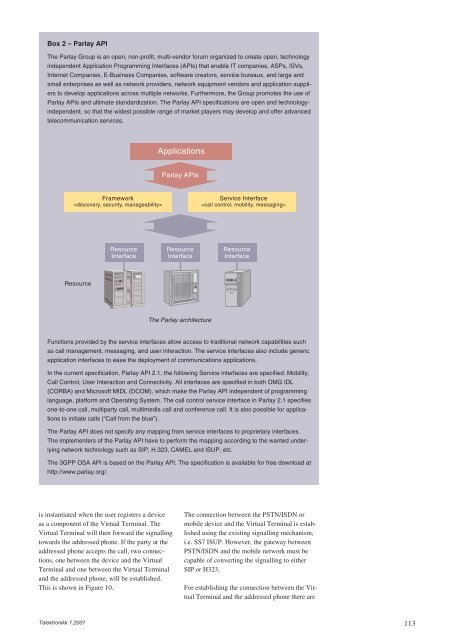Create successful ePaper yourself
Turn your PDF publications into a flip-book with our unique Google optimized e-Paper software.
Box 2 – Parlay API<br />
The Parlay Group is an open, non-profit, multi-vendor forum organized to create open, technology<br />
independent Application Programming Interfaces (APIs) that enable IT companies, ASPs, ISVs,<br />
Internet Companies, E-Business Companies, software creators, service bureaux, and large and<br />
small enterprises as well as network providers, network equipment vendors and application suppliers<br />
to develop applications across multiple networks. Furthermore, the Group promotes the use of<br />
Parlay APIs and ultimate standardization. The Parlay API specifications are open and technologyindependent,<br />
so that the widest possible range of market players may develop and offer advanced<br />
telecommunication services.<br />
Framework<br />
<br />
Resource<br />
Functions provided by the service interfaces allow access to traditional network capabilities such<br />
as call management, messaging, and user interaction. The service interfaces also include generic<br />
application interfaces to ease the deployment of communications applications.<br />
In the current specification, Parlay API 2.1, the following Service interfaces are specified: Mobility,<br />
Call Control, User Interaction and Connectivity. All interfaces are specified in both OMG IDL<br />
(CORBA) and Microsoft MIDL (DCOM), which make the Parlay API independent of programming<br />
language, platform and Operating System. The call control service interface in Parlay 2.1 specifies<br />
one-to-one call, multiparty call, multimedia call and conference call. It is also possible for applications<br />
to initiate calls (“Call from the blue”).<br />
The Parlay API does not specify any mapping from service interfaces to proprietary interfaces.<br />
The implementers of the Parlay API have to perform the mapping according to the wanted underlying<br />
network technology such as SIP, H.323, CAMEL and ISUP, etc.<br />
The 3GPP OSA API is based on the Parlay API. The specification is available for free download at<br />
http://www.parlay.org/.<br />
is instantiated when the user registers a device<br />
as a component of the Virtual Terminal. The<br />
Virtual Terminal will then forward the signalling<br />
towards the addressed phone. If the party at the<br />
addressed phone accepts the call, two connections,<br />
one between the device and the Virtual<br />
Terminal and one between the Virtual Terminal<br />
and the addressed phone, will be established.<br />
This is shown in Figure 10.<br />
Telektronikk 1.2001<br />
Resource<br />
Interface<br />
Applications<br />
Parlay APIs<br />
Resource<br />
Interface<br />
The Parlay architecture<br />
Service Interface<br />
<br />
Resource<br />
Interface<br />
The connection between the PSTN/ISDN or<br />
mobile device and the Virtual Terminal is established<br />
using the existing signalling mechanism,<br />
i.e. SS7 ISUP. However, the gateway between<br />
PSTN/ISDN and the mobile network must be<br />
capable of converting the signalling to either<br />
SIP or H323.<br />
For establishing the connection between the Virtual<br />
Terminal and the addressed phone there are<br />
113

















